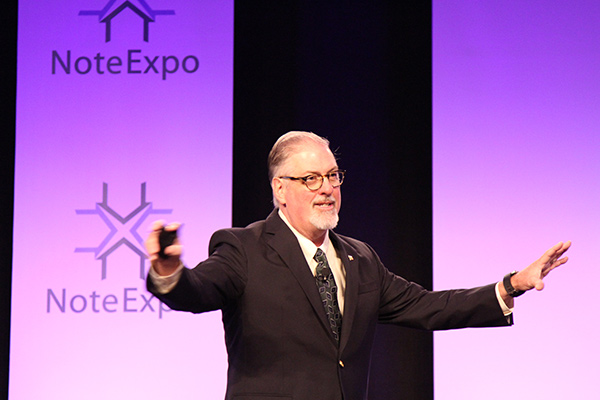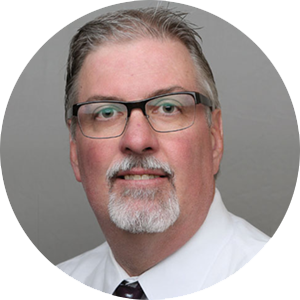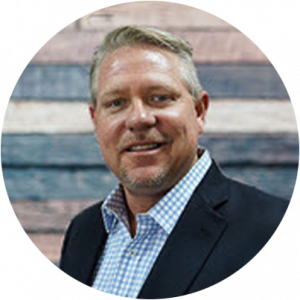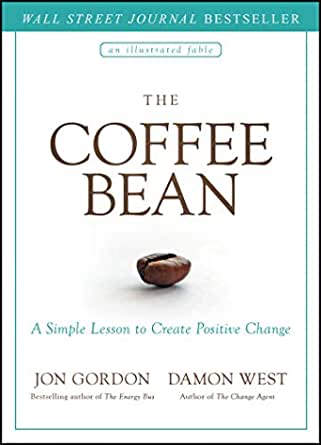Thoughts from the Desk of
Bob Repass…
If someone surveyed you on the top reasons you attend an industry conference and trade show, I’m betting your response would fall into one of these three buckets:
- To learn from the speakers and sessions – Content
- To network – Connections
- To be around others that are active in the note business – Community
Those three reasons, Content, Connections and Community sum up exactly why we created NoteExpo 8 years ago!
As industry professionals having attended and spoken at many years of seminars, conferences, and events, we have found that while they all had at least some value, something is still missing. This is the reason why we continue to host NoteExpo – to provide a curated experience that delivers value to all those who participate.
Our content sessions are broken down into three categories. First, we have our general sessions where we feature speakers such as our very own Eddie Speed, Mike Griffith from FCI Lender Services, Tracy Rewey of NoteInvestor.com, Jeff Watson and our Keynote speaker Shaun McCloskey.
Second, we have our NOTE Talks – which is our version of TED Talks where you will hear stories from folks all across the note business as they describe their journey. This year we’ll hear from Jack Krupey, Chaz Guinn, Martha Speed, Marishka Pilch, Tim Griffith and yours truly just to name a few.
Finally, we have our panel discussions where we will dive deep into the latest industry trends and what we see coming in the NPL market, along with NPL Due Diligence and a look ahead to 2022 and investing with your SDIRA funds.
In addition to top speakers delivering insights into the future of note investing, we also have dozens of vendors, lenders, and exhibitors. You can make more new contacts in less time than anywhere else!
We’re excited that NoteExpo 2021 will once again be meeting in person this November 5-6. NoteExpo 2021 is not just another real estate conference. It’s the industry’s TOP event for note investors at every level of experience.
The entire note industry looks forward to NoteExpo every year because it helps you adjust your investment strategies for the year ahead. This is our 8th NoteExpo, and it’s going to be the best by far!
CLICK HERE and use Promo code Expo to secure your spot!
Bob Repass
Managing Director

Stay up to Speed with Eddie
CATCH THE VISION
by Eddie Speed
You may have noticed there are three types of people in the world:
- Those who make things happen.
- Those who watch things happen.
- Those who wonder what happened.
My job as a teacher and mentor is to help people in Group 1 get even better at making things happen. I also help people from Groups 2 and 3 move up the ladder into Group number 1.
Group 1 is where the entrepreneurs are. They love taking the initiative and don’t hesitate to step out of their comfort zone to make things happen. They’re highly motivated, but there are some who approach business with a “Fire, ready, aim” mindset. If you start making deals before you know what you’re doing you can make some very expensive mistakes. They’re born with fire in their belly, but they need knowledge and training to be a success.
The folks in Group 2 might be just as smart as the people in Group 1. Surprising as it may seem, they might be even smarter (on an IQ test). But something is holding them back. They’re not catching the vision. They’re like the first baseman who gets a ball thrown to him for an easy out, but it sails past him because he’s too busy thinking about physics and trajectory and gravity and wind velocity. This group sometimes think that before they ever make their first deal, they need to have every answer to every possible question that might possibly arise. To the folks in Group 2, even something perfect is never perfect enough. They don’t lack intelligence nor competence; they just lack tenacity and confidence. My job is to boost their confidence and their “want-to” and get them equipped with enough information to make their first deal. Then they catch the vision and realize how much more fun it is to be in Group 1.
As for group 3, well, they’re just clueless. Some people are so clueless they don’t even know they’re clueless! But just because they’re clueless does NOT mean they’re hopeless. I know that’s true because I started my career in Group 3! (The only financial advice I could give anybody was: Never pay extra for a large Dr. Pepper if refills are free.) As long as a person knows they’re clueless that’s a fantastic starting point—because they know they need to learn. I’ve trained tons of folks that started out in Group 3 who ultimately leapfrogged over many of the people in Group 2 to join the happy entrepreneurs in Group 1.
THERE’S ALWAYS A CHECKLIST BEFORE TAKEOFF
Over the years, I frequently used a private Cessna to fly around the country looking at properties. I have well over a thousand hours in the righthand seat of the cockpit. No, I was not the pilot, and I really can’t even say I was the co-pilot. I had one specific job as I sat in the righthand seat: Don’t bother the pilot!
There was a time when I considered getting a pilot’s license, but my dad wisely brought me back down to earth. He told me I’d have too much trouble focusing on flying the plane because I have so many other thoughts flying around inside my head.
Occasionally the pilot would let me take the yoke, probably for his own amusement. It was the top of my game just trying to keep the plane flying straight! I was always happy to turn the controls back to the pilot (once he stopped laughing).
But I did learn a very important lesson—the absolute necessity of having a checklist to review before takeoff. I often went through the checklist with the pilot. (If I ever saw him skip anything I knew to find another pilot!) By the way, the checklist on the modest Cessna I flew on was fourteen pages!
It takes patience to go through every single item on the checklist before heading for the runway. If you skim quickly through your checklist, the plane might take off; but if just one item on your checklist isn’t looked at closely, you may not reach the next airport.
If you want to be a pilot, you’re required to get trained and get a license. By comparison, there’s no required license to be a note investor. But without proper training you can crash and burn financially.
I wouldn’t own NoteSchool if people didn’t require training to succeed in the note business. We teach the mechanical formulas of how to do a note deal, which are much like a pilot’s checklist. We share lots of case studies that demonstrate how people applied the formulas that we teach. (People always love and remember the case studies because they bring the formulas to life.)
Lots of my students (in Group 1) are so eager to head for the runway to start making deals that they’re tempted to ignore the checklist. But some of the folks in Group 2 are like the pilot that reviews his checklist a dozen times but never takes the plane out of the hangar.
One of the signs that a newly trained pilot is ready for their first solo flight is that they think they aren’t ready! Even though they know enough to take their first flight, they’re smart enough to know how much they don’t know. Once their instructor gives them an encouraging nudge to take their first solo flight, they realize how exhilarating it is—and how much they still need to learn.
Just like those newly minted pilots, all note investors have gaps in what we know, so the learning process never stops. Lifelong learning is a hallmark of entrepreneurs.
DON’T “OUT-THINK” THE DEAL
When I first started training people on the art of creative financing, I shared the microphone with a brilliant man and great friend named Hank Harenberg. He has since passed away but the wisdom he shared lives on.
He always told our new students, “Don’t out-think the deal.” What exactly does that mean? Well, it sure doesn’t mean you should turn off your brain. It means don’t let the multiple tools in your toolbox, the length of your checklist, and the complexities of the business keep you from moving forward. Lots of new investors suffer “paralysis by analysis” and it prevents them from making their first deal. One of the great things about being plugged into our NoteSchool community is that if there’s something you don’t know you can rest assured that there’s someone who does know it and can answer your question.
Today’s opportunities as a note investor are huge. About 35% of people who want a mortgage can’t get approved from traditional lenders, so they need creative financing. That opens a gigantic door for entrepreneurs to fill the gap. But an opportunity without knowledge won’t help you much.
My advice for you to succeed is: Catch the vision, learn the checklist, build your confidence, and spread your wings!
Capital Markets Update
Managing Your Health in a Post-Covid World
By: Ryan Parson
We have all felt the effects of Covid-19. For some, the challenges have been minor annoyances, while for others, the impacts have been fundamentally life-altering.
Regardless of how the virus has affected your personal health, chances are that it has made a difference in the health care you receive and how you are able to access it.
Covid’s lasting effect on health care delivery and access
When Covid first hit, many medical offices and primary care facilities across the country were essentially closed to anyone who wasn’t infected with the virus. Routine checkup visits, preventive care treatments, and elective procedures were pushed off or canceled entirely as hospitals and health care workers focused on addressing Covid. Other factors also put-up roadblocks to access, for example, inadequate supplies of personal protective equipment meant that many health care facilities could not create a Covid-safe environment for patients or providers. Indeed, it’s highly likely that you had to delay some sort of test or procedure during the past year and a half, or you felt it was in your best interest to avoid walking into a doctor’s office, clinic or emergency room during the worst periods of Covid.
If you think such delays are a thing of the past, think again. Even when Covid is far in the rearview mirror, traditional or easy access to health care services could remain constrained for years or decades to come. It’s possible we may never fully return to “normal” health care delivery which creates angst about the future of healthcare availability.
Here is why:
Fewer physicians. Many health care professionals – including highly experienced physicians – decided to leave the industry entirely in the wake of Covid, due in part to the workload and stress they experienced trying to care for so many patients as the virus surged and surged again. On top of that, many physicians actually saw their pay cut during the pandemic because those moneymaking elective procedures were put on hold.
More relatively inexperienced professionals. As physicians exit. different types of health care workers and professionals, such as nurse practitioners and physician assistants, are increasingly entering the field. These mid-level professionals, while extremely talented and hardworking, simply don’t have the same experience or credentials as physicians do. Over time, this may lead to a reduction in the services or expertise that health care providers can capably deliver.
The wave of aging baby boomers. If the supply side of the health care system seems shaky, the demand side is ramping up like never before. Baby boomers will need more and more health care as they age into their 70s, 80s and 90s, and likely live longer than past generations.
Taking charge of your own care
Embrace telehealth.
Telemedicine is designed to diagnose and treat patients remotely – without the physical presence of a health care provider. Instead, patients and providers exchange information through online video chats, emails and phone calls. In its most advanced form, telemedicine allows doctors to monitor their patients’ health and vitals remotely using technology. This approach is designed to help make access to health care easier and faster.
Consider concierge practices.
Concierge medicine is a blanket term covering a wide variety of health care delivery models. Essentially, however, concierge medicine is a membership model: For a fee, concierge practices don’t accept insurance in most cases, you get access to medical practices with relatively small ratios of patients to physicians. The results can include shorter wait times, longer visits and significantly more personalized care, given (in many cases) by physicians with greater expertise than the typical provider. The fee-based, noninsurance approach also means that care is far less likely to be denied or watered down in the name of profits – a real benefit if, for example, you’re given a diagnosis that you’d like to address with extensive or highly specialized care.
Manage your own risk.
Helping you be as healthy as possible may not be “top of mind” in an overburdened, understaffed health care industry and a for-profit health system. Like with most all elements of your wealth, you are in charge. Your health is no different. Consider becoming your own “primary care provider” as much as you possibly can, by both making better health decisions and working with providers to track key metrics that can help you get a more personalized picture of any health risks that may need to be mitigated.
The obvious key metrics and procedures are the ones you can track and manage largely by yourself including your weight, the number of steps you take each day, your blood pressure, home breast exams and so on. Quality sleep is often an area of our health that is overlooked. Not having enough sleep can lead to degenerative illnesses, cardiovascular disease and premature death. To get a truly, good night’s sleep consistently, take steps such as these:
*Get seven to eight hours every night
*Limit exposure to blue light at least one hour before bedtime (by using the “night shift” feature on your iPhone/iPad, for example).
*Avoid eating within two hours before you go to bed
*Avoid taking hot showers or vigorously exercising within three to four hours of going to bed
Be prepared to advocate strongly for yourself if you’re using a traditional private insurance approach.
Ultimately, the look and feel of health care may be significantly different in the years to come. By preparing yourself today, you can better navigate that transition and put yourself in the best possible position to get the care you want and need, especially when you need it.
To your financial independence,
Ryan Parson
The Trading Corner
Determining a Note’s Value
By: Scot Tyler
This is a typical question asked of me from most every new note flipper or even a note seller on a regular basis. “How do I determine the cash value of a note and what price should I offer the seller?” Of course, there are many ways to decide what the price of a note is and there are many variations of opinions as to how to determine the value, but here is a quick and effective process to consider.
When reviewing your next asset to value, run through these quick and effective processes before delivering your offer.
- Review the collateral – what is the asset securing the loan? Is the property value today at or above the original sales price? What is the age and current condition of the property? What’s around the subject property? How is the crime in the area? What is the population of the city the asset is sitting in? Have there been any recent natural disasters in the area and if so, was this property affected? What is employment like in the area?
- Terms of the note – how much was the property financed for? What interest rate is the loan carrying? How long was the loan made for? Is there a balloon? When was the loan originated and when was the first payment due/made? Has the borrower made all payments as agreed? Once you have the terms you confirm the loan amortizes as stated.
- Borrower information – how is the borrower repaying the debt? Are his monthly payments always on time? Is he a late payor or maybe rolling 30 days delinquent? How does the borrower make the payments? Does he pay in cash, check, money order, ACH? Does the borrower occupy the property, or it used as rental? Did the seller run a credit report or know anything about the borrower before he sold to them? Did the borrower rent the property before purchase and if so for how long? How much of a down payment did the borrower provide at closing? Was that a cash down payment, rental credit or maybe sweat equity?
Now that you have examined the property, loan terms and borrower information and you are pleased with what you have found, it is now time to determine the price you should offer for the note. The foundation for determining your price is based upon knowing what the current unpaid balance (UPB) is and establishing what return you would like on your money.
For example, the established UPB on the note is $83,865 and a fair market value of approximately $120,000 (70% LTV). The monthly payment is $1,136.50, remaining term is 115 months, note rate is 10% and you would like a 15% return on your investment in this note.
Many people use different financial calculators, but I continue to use the dinosaur HP-12C that I have used since the mid 1990’s. Here is an on-line link where you can download the calculator to your desktop, HP-12C Platinum – Download (softonic.com).
Input the following in your financial calculator:
- Input 115 remaining payments and place in “n” (amort)
- Input $83,865.00 (UPB) in “PV” (present value) and then select “CHS” and PV again to a negative – (should look like this in PV -$83,865.00)
- Input $1136.50 in “PMT” (payment amount)
- Solve for “I” (interest rate) which will be 0.83% * 12 months = 10%
Now you have the remaining loan terms in your registry. Again, you had decided you want a 15% return on your money so go back to the financial calculator and input the 15% to see what you would pay for the loan.
- Type 15, then select “g” and then “i” (which converts the interest rate into a monthly % / 1.25%) and then solve for “PV”. This will provide the amount you will want to pay the note seller to have a return of 15% on this specific loan.
If you calculated the return correctly the amount you should pay to earn the 15% return is $69,131.33. Were you able to get the same amount/return? The old saying “practice makes perfect” definitely applies here. It took me many months to conquer the HP-12C but today I will use it before I use a regular calculator. Each loan you review make sure you are considering all of the factors before delivering your offer to the note seller. Purchasing notes is a mixture of facts, applying common sense and then determining the future performance of the note.
Here is a note that came across our trade desk that we recently funded. If you’re interested in purchasing it, email me at: [email protected]
Performing Loan – Single Family Residence – Owner Occupied
Mount Vernon, NY
BPO $385,000.00 – April 2021
$390,000 sales price with $33,000 cash down
$357,000 / 6.0% / $2,140.40 30 yr am with a 3 year balloon
5 made / 31 left with $343,019 balloon due
Current UPB $355,205.00
Until next month.
This Month’s Poll Question
Connect With Us
Are you on Twitter? If so, be sure to follow us on Twitter @NoteSchool and @ColCapMgmt, if not, why not?






 Though this book is only 112 pages it is filled with an inspiring message. The Coffee Bean: A Simple Lesson to Create Positive Change by Damon West & Jon Gordon uses a “fable” to show anyone young or old, how you can transform your environment, overcome challenges and create positive change. This book was inspired by co-author Damon West’s personal journey from a college football athlete to a drug addict to a convicted felon and now a motivational speaker, his story of redemption, grace and humility is an inspiration for all. Check out his story and the story behind the book
Though this book is only 112 pages it is filled with an inspiring message. The Coffee Bean: A Simple Lesson to Create Positive Change by Damon West & Jon Gordon uses a “fable” to show anyone young or old, how you can transform your environment, overcome challenges and create positive change. This book was inspired by co-author Damon West’s personal journey from a college football athlete to a drug addict to a convicted felon and now a motivational speaker, his story of redemption, grace and humility is an inspiration for all. Check out his story and the story behind the book